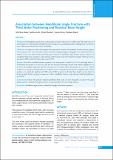Please use this identifier to cite or link to this item:
https://hdl.handle.net/20.500.14356/1042| Title: | Association between Mandibular Angle Fracture with Third Molar Positioning and Residual Bone Height |
| Authors: | Haque, Ishfa Banu Joshi, Sandhya Bhandari, Kishor Karna, Gaurav Khanal, Bandana |
| Citation: | HaqueI. B., JoshiS., BhandariK., KarnaG., & KhanalB. (2022). Association between Mandibular Angle Fracture with Third Molar Positioning and Residual Bone Height. Journal of Nepal Health Research Council, 20(01), 207-212. https://doi.org/10.33314/jnhrc.v20i01.4187 |
| Issue Date: | 2022 |
| Publisher: | Nepal Health Research Council |
| Article Type: | Original Article |
| Keywords: | Mandibular angle fracture residual bone height third molar impaction |
| Series/Report no.: | Jan-March, 2022;4187 |
| Abstract: | Abstract Background: Mandibular angle fracture are frequently associated with presence of third molar. This study aimed at assessing the role of third molar with angle fracture in relation to its positioning and the remaining bone between the apex of third molar and inferior border of mandible. Methods: A retrospective study of all patients who reported for treatment of mandibular fracture between January 2019 to January 2021 were undertaken. Patient’s data and orthopantamogram radiographs were obtained from there medical records. The collected data included presence/absence of mandibular angle fracture, presence/absence of mandibular third molar, angulation and positioning of third molar along with residual bone height. Statistical analysis was done in SPSS version 20 with p-value set at p<0.05 Results: Total of 86 mandibular fracture reported in the study period, of which 34 (39.53%) had angle fracture. Third molar was present in 31 (45.6%) cases and was associated with angle fracture with statistical significance of p<0.026. Mesioangular impaction (86.4%) with class II (57%) ramus relation and position B (72.7%) in occlusal relation were associated with angle fracture in comparison to non-angle fracture group where angulation and occlusal position were statistically significant p<0.001 and p=0.002, respectively. Residual bone height was also found to be less in angle fracture group in comparison to other mandibular fracture group showing statistical significance (p<0.023). Conclusions: Patient with partially erupted mandibular third molar are more frequently associated with angle fracture and the residual bone height could also be a good predictor for risk of angle fracture. Keywords: Mandibular angle fracture; residual bone height; third molar impaction. |
| Description: | Original Article |
| URI: | http://103.69.126.140:8080/handle/20.500.14356/1042 |
| ISSN: | Print ISSN: 1727-5482; Online ISSN: 1999-6217 |
| Appears in Collections: | Vol. 20 No. 01 (2022): Issue 54 Jan-March, 2022 |
Files in This Item:
| File | Description | Size | Format | |
|---|---|---|---|---|
| 4187-Manuscript-27894-1-10-20220606.pdf | Fulltext Download | 214.26 kB | Adobe PDF |  View/Open |
Items in DSpace are protected by copyright, with all rights reserved, unless otherwise indicated.
